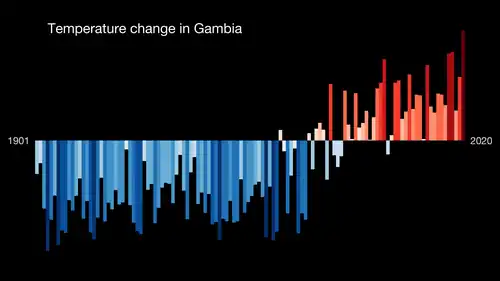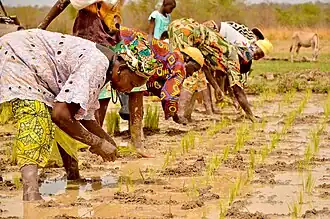Climate change in the Gambia
Climate change in the Gambia is having impacts on the natural environment and people of The Gambia.[4] Like other countries in West Africa, the impacts of climate change are expected to be varied and complex. Climate change adaptation is going to be important to achieve the Sustainable Development Goals in the country.[4][5]
Greenhouse gas emissions
The Gambia's greenhouse Gas emissions are relatively low in relation to the global greenhouse emission scale. However, the country has country has taken actions with efforts to reduce them by developing the Gambia's Long-term Climate-Neutral Development Strategy 2025 in 2012.[6] The country is said to be responsible for only 0.05% of the world's GHG emission.[7] As of 2010, the biggest percentage of the country's GHG emission was from Land-use, land-use change and forestry (LULUCF) though before that up to around 1998, LULUCF acted as the country's carbon sink.[8]
Impacts on the natural environment

The Sahel climate makes the eco region particularly vulnerable to changes in water.[5] Climate change is expected to increase or make more severe windstorms, floods, droughts, and coastal erosion and saltwater intrusion.[5][9]
Temperature and weather changes
Since the 1940 to around 2010, the temperatures in the West Africa have noticeably increased and since 1960, the mean annual temperatures in Gambia have increased by 1.0 °C with an average rate of 0.21 °C per decade.[10]
Gambia experiences a Sahelian climate which is characterized by long, dry seasons between November to may and a short, wet season between June to October.[10] During dry seasons, the average temperatures range between 18 °C to 30 °C and 23 °C to 33 °C during wet seasons.[10]
Impacts on people
Economic impacts
Agriculture is 26% of the GDP and employs 68% of the labor force.[5] Much of the agriculture is rain fed, so changes in precipitation will have significant impacts.[5] In 2012, drought plus increased food prices led to a food crisis in the region.[9] Rice farmers near the coast are also experiencing saltwater intrusion.[9]

Fisheries are also vulnerable, with changes to breeding grounds for coastal fishery species putting additional pressure on already unsustainable fishery practices.[5]
Infrastructure is already seeing major losses from flooding and windstorms. For example, urban floods in 2020 severely damaged at least 2371 houses, and destroyed crops.[5]
Mitigation and adaptation
Policies and legislation
The Gambia has published a Climate Change Priority Action Plan that focuses on 24 cross-sectoral activities.[11]
International cooperation
United Nations Environment Programme started a $20.5 million project in partnership with the Government of Gambia to restore forests and marginal agricultural land.[12]
References
- ^ Hausfather, Zeke; Peters, Glen (29 January 2020). "Emissions – the 'business as usual' story is misleading". Nature. 577 (7792): 618–20. Bibcode:2020Natur.577..618H. doi:10.1038/d41586-020-00177-3. PMID 31996825.
- ^ Schuur, Edward A.G.; Abbott, Benjamin W.; Commane, Roisin; Ernakovich, Jessica; Euskirchen, Eugenie; Hugelius, Gustaf; Grosse, Guido; Jones, Miriam; Koven, Charlie; Leshyk, Victor; Lawrence, David; Loranty, Michael M.; Mauritz, Marguerite; Olefeldt, David; Natali, Susan; Rodenhizer, Heidi; Salmon, Verity; Schädel, Christina; Strauss, Jens; Treat, Claire; Turetsky, Merritt (2022). "Permafrost and Climate Change: Carbon Cycle Feedbacks From the Warming Arctic". Annual Review of Environment and Resources. 47: 343–371. doi:10.1146/annurev-environ-012220-011847.
Medium-range estimates of Arctic carbon emissions could result from moderate climate emission mitigation policies that keep global warming below 3°C (e.g., RCP4.5). This global warming level most closely matches country emissions reduction pledges made for the Paris Climate Agreement...
- ^ Phiddian, Ellen (5 April 2022). "Explainer: IPCC Scenarios". Cosmos. Archived from the original on 20 September 2023. Retrieved 30 September 2023.
"The IPCC doesn't make projections about which of these scenarios is more likely, but other researchers and modellers can. The Australian Academy of Science, for instance, released a report last year stating that our current emissions trajectory had us headed for a 3°C warmer world, roughly in line with the middle scenario. Climate Action Tracker predicts 2.5 to 2.9°C of warming based on current policies and action, with pledges and government agreements taking this to 2.1°C.
- ^ a b "Weathering the uncertainties of climate change in The Gambia". Africa Renewal. 2018-03-09. Retrieved 2020-10-12.
- ^ a b c d e f g Jaiteh, Malanding S.; Sarr, Baboucarr. Climate Change and Development in the Gambia (PDF) (Report) – via Columbia University.
- ^ Government of The Gambia, Ministry of Environment, Climate Change and Natural Resources (2012). "THE GAMBIA`S LONG-TERM CLIMATE-NEUTRAL DEVELOPMENT STRATEGY 2050" (PDF). 1.
{{cite journal}}: CS1 maint: multiple names: authors list (link) - ^ "Gambia takes a stand on reducing emissions". World Agroforestry | Transforming Lives and Landscapes with Trees. Retrieved 2025-08-11.
- ^ "The Gambia". climateactiontracker.org. Retrieved 2025-08-11.
- ^ a b c "What farmers in The Gambia are doing about climate change". ActionAid USA. Retrieved 2020-10-12.
- ^ a b c "World Bank Climate Change Knowledge Portal". climateknowledgeportal.worldbank.org. Retrieved 2025-08-11.
- ^ "The Gambia". World Bank Climate Change Knowledge Portal. Retrieved 2020-10-12.
- ^ Environment, U. N. (2018-02-06). "In The Gambia, building resilience to a changing climate". UN Environment. Retrieved 2020-10-12.

